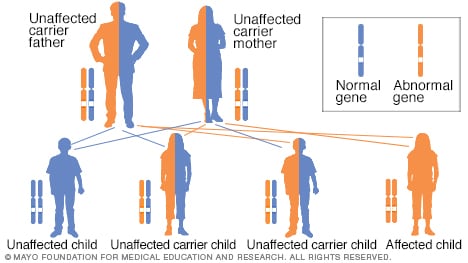Wilson's disease
Wilson's disease
overview
The liver

The liver
The liver is your largest internal organ. It's about the size of a football and is located primarily in the upper right part of your abdomen - below the diaphragm and above your stomach. A small portion extends into the upper left quadrant.
Wilson's disease is a rare inherited disorder that causes copper to build up in your liver, brain, and other vital organs. Most people with Wilson's disease are diagnosed between the ages of 5 and 35, but it can also affect younger and older people.
Copper plays a key role in the development of healthy nerves, bones, collagen and the skin pigment melanin. Normally, copper is absorbed from your diet and excess copper is excreted through a substance produced in your liver (bile).
But in people with Wilson's disease, copper is not excreted properly and instead accumulates, possibly to life-threatening levels. If diagnosed early, Wilson's disease is treatable, and many people with the condition lead normal lives.
Treatment of Wilson's disease
Symptoms
Wilson's disease is present at birth, but signs and symptoms do not appear until copper builds up in the brain, liver or other organs. Signs and symptoms vary depending on the parts of the body affected by the disease. They may include:
- Müdigkeit, Appetitlosigkeit oder Bauchschmerzen
- Eine Gelbfärbung der Haut und des Weißen im Auge (Gelbsucht)
- Goldbraune Augenverfärbung (Kayser-Fleischer-Ringe)
- Flüssigkeitsansammlung in den Beinen oder im Bauch
- Probleme mit Sprache, Schlucken oder körperlicher Koordination
- Unkontrollierte Bewegungen oder Muskelsteifheit
When to go to the doctor?
Make an appointment with your doctor if you have signs and symptoms that worry you, especially if a family member has Wilson's disease.
Causes
Autosomal recessive inheritance pattern

Autosomal recessive inheritance pattern
To have an autosomal recessive disorder, you inherit two altered genes (mutations), one from each parent. These diseases are usually passed on between two carriers. Their health is rarely affected, but they have an altered gene (recessive gene) and an unaffected gene (dominant gene) for the disease. Two carriers have a 25 percent chance of having an unaffected child with two unaffected genes (left), a 50 percent chance of having an unaffected child who is also a carrier (center), and a 25 percent chance of having an affected child with two recessively altered genes (right).
Wilson's disease is inherited in an autosomal recessive manner, meaning you must inherit one copy of the defective gene from each parent to develop the disease. If you get just one abnormal gene, you won't get sick yourself, but you will be a carrier and can pass the gene on to your children.
Risk factors
You may be at increased risk of Wilson's disease if your parents or siblings have the disease. Ask your doctor if you should undergo genetic testing to find out if you have Wilson's disease. Diagnosing the disease as early as possible dramatically increases the chances of successful treatment.
Complications
Normal liver vs. cirrhosis of the liver

Normal liver vs. cirrhosis of the liver
A typical liver (left) shows no signs of scarring. In cirrhosis (right), scar tissue replaces typical liver tissue.
If left untreated, Wilson's disease can be fatal. Serious complications include:
- Vernarbung der Leber (Zirrhose). Wenn Leberzellen versuchen, Schäden durch überschüssiges Kupfer zu reparieren, bildet sich in der Leber Narbengewebe, das die Funktion der Leber erschwert.
- Leberversagen. Dies kann plötzlich auftreten (akutes Leberversagen) oder sich langsam über Jahre entwickeln. Eine Lebertransplantation könnte eine Behandlungsoption sein.
- Anhaltende neurologische Probleme. Zittern, unwillkürliche Muskelbewegungen, ungeschickter Gang und Sprachschwierigkeiten bessern sich normalerweise mit der Behandlung von Morbus Wilson. Einige Menschen haben jedoch trotz Behandlung anhaltende neurologische Probleme.
- Nierenprobleme. Die Wilson-Krankheit kann die Nieren schädigen und zu Problemen wie Nierensteinen und einer abnormalen Anzahl von Aminosäuren führen, die im Urin ausgeschieden werden.
- Psychologische Probleme. Dazu können Persönlichkeitsveränderungen, Depressionen, Reizbarkeit, bipolare Störungen oder Psychosen gehören.
- Blutprobleme. Diese können die Zerstörung roter Blutkörperchen (Hämolyse) umfassen, was zu Anämie und Gelbsucht führt.
Treatment of Wilson's disease
Sources:
- Shilsky ML. Wilson-Krankheit: Klinische Manifestationen, Diagnose und Naturgeschichte. https://www.uptodate.com/home. Abgerufen am 22. Juni 2017.
- Fragen Sie MayoExpert. Wilson-Krankheit. Rochester, Minnesota: Mayo Foundation for Medical Education and Research; 2017.
- Pazirandeh S. et al. Überblick über Spurenelemente in der Nahrung. https://www.uptodate.com/home. Abgerufen am 22. Juni 2017.
- Wilson-Krankheit. Nationales Institut für Diabetes und Verdauungs- und Nierenerkrankungen. https://www.niddk.nih.gov/health-information/liver-disease/wilson-disease. Abgerufen am 22. Juni 2017.
- Shilsky ML. Morbus Wilson: Behandlung und Prognose. https://www.uptodate.com/home. Abgerufen am 22. Juni 2017.
- Bandmann O, et al. Morbus Wilson und andere neurologische Kupfererkrankungen. Die Lancet-Neurologie. 2015;14:103.
- Wilson-Krankheit. Amerikanische Leberstiftung. http://www.liverfoundation.org/abouttheliver/info/wilson/. Abgerufen am 22. Juni 2017.
- Riggin EA. AllScripts EPSi. Mayo Clinic, Rochester, Minnesota, 23. Juni 2017.

 Suche
Suche
 Mein Konto
Mein Konto